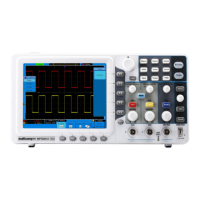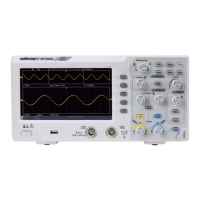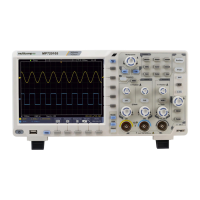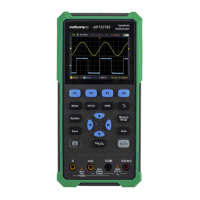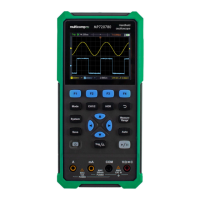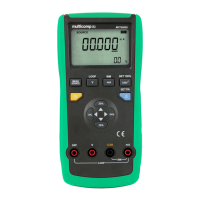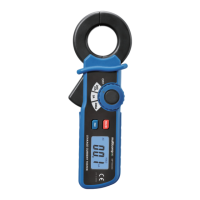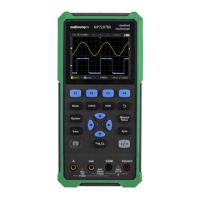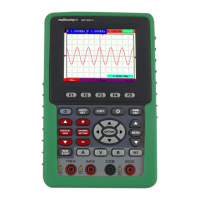Do you have a question about the multicomp pro MP720025 and is the answer not in the manual?
Describes the operation and function of the oscilloscope's front panel.
Details the controls, buttons, and connectors on the front panel.
Details the ports and connectors on the rear panel.
Explains the various buttons and rotary controls in the control area.
Introduces the graphical user interface and its various elements.
Provides steps for performing a general inspection of the oscilloscope.
Guides the user through a fast check to verify normal instrument operation.
Explains how to adjust the probe to match the input channel.
Details how to change or check the probe's attenuation coefficient.
Provides safety guidelines for using the oscilloscope probe.
Explains the self-calibration procedure to optimize measurement accuracy.
Describes the buttons and rotary controls for the vertical system.
Explains the controls for setting the horizontal time base.
Introduces the trigger controls, including level, force, and menu buttons.
Details how to operate the oscilloscope using touchscreen gestures.
Explains how to configure the vertical controls for channels and math functions.
Describes how to use math functions like addition, subtraction, and FFT.
Explains how to configure the horizontal controls for time base and position.
Guides on setting up trigger conditions and decoding signals.
Introduces bus triggering, covering RS232, I2C, SPI, and CAN.
Explains how to decode serial bus signals like RS232, I2C, SPI, CAN.
Details how to configure sampling parameters like acquisition mode and record length.
Explains how to configure display settings like type, persistence, and color.
Guides on saving and recalling waveforms, configurations, and screen images.
Guides on updating the oscilloscope's firmware using a USB memory device.
Explains how to use the automatic measurement feature.
Guides on using cursors for time and voltage measurements.
Guides on printing the oscilloscope screen image to a printer.
Details how to connect the generator output ports.
Details how to set parameters for outputting sine waveforms.
Guides on setting parameters for square waveforms.
Guides on setting parameters for ramp waveforms.
Guides on setting parameters for pulse waveforms.
Guides on setting parameters for arbitrary waveforms.
Details the steps for creating and editing user-defined waveforms.
Describes how to select from the 46 built-in arbitrary waveforms.
Explains how to perform frequency response analysis.
Describes the multimeter input terminals on the oscilloscope.
Details the bottom menu options for the multimeter function.
Provides step-by-step guides for performing various multimeter measurements.
Details how to measure AC and DC current within different ranges.
Details how to measure AC and DC voltage.
Details how to measure resistance.
Details how to test diodes using the multimeter.
Details how to test for continuity.
Details how to measure capacitance.
Explains how to use the multimeter data recorder.
Details the steps for connecting the oscilloscope to a PC using a USB port.
Explains how to connect the oscilloscope to a PC using a LAN port.
Explains how to connect the oscilloscope to a PC wirelessly via Wi-Fi.
Guides on connecting the oscilloscope to a PC via an existing Wi-Fi network.
Details the two connection types: WIFI-AP and WIFI-STA.
Details how to set up the oscilloscope as a Wi-Fi access point.
Demonstrates measuring signal frequency and peak-to-peak voltage.
Shows how to capture non-periodic signals using trigger settings.
Explains how to analyze signal details like noise and use Peak Detect.
Demonstrates using the X-Y function to examine phase difference.
Demonstrates setting up video triggers to observe stable video signals.
Details performance characteristics of the oscilloscope.
Lists general technical specs like display, power, environment, mechanical.
Lists standard and optional accessories included with the oscilloscope.
Provides guidelines for the general care and cleaning of the instrument.
Offers guidance on charging, replacing, and disposing of the battery.
| Category | Test Equipment |
|---|---|
| Model | MP720025 |
| Type | Digital Multimeter |
| Display Type | LCD |
| Display Digits | 3.5 |
| DMM Functions | AC/DC Voltage, AC/DC Current, Resistance, Capacitance, Frequency, Temperature |
| AC Voltage Max | 600V |
| DC Voltage Max | 600V |
| AC Current Max | 10A |
| DC Current Max | 10A |
| Resistance Max | 20MΩ |
| Safety Category | CAT III 600V |
| Voltage Range (AC) | 200mV to 600V |
| Voltage Range (DC) | 200mV to 600V |
| Current Range (AC) | 200μA to 10A |
| Current Range (DC) | 200μA to 10A |
| Resistance Range | 200Ω to 20MΩ |
| Temperature Range | -20°C to 1000°C |
| Safety Rating | CAT III 600V |
| Battery Type | 9V |
| Frequency Range | 20kHz |
